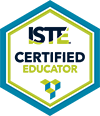Media Literacy: Helping Elementary Students Thrive in the Digital World
,
Colorado Convention Center, Bluebird Ballroom Lobby, Table 41
Presenters



Session description
Purpose & objective
- Participants will understand what a digital footprint it, how to talk to elementary students about it, and resources that are available to aid in teaching
- Participants will leave with a list of 5 things to think about or implement in their practice to help with digital citizenship at home and at school.
- Participants will learn about how educators across the us are implementing media literacy best practices in their communities.
--Participants will receive of list of people who are doing amazing things in their communities to follow on social and learn along with their projects.
Outline
Content and Activities:
Digital citizenship: What is digital citizenship? Why is it important for elementary students? Real-life examples of how digital citizenship is being addressed in elementary schools. Resources for teaching digital citizenship in the classroom.
Questions I will address for Digital Footprint include :What is a digital footprint? How can elementary students protect their digital footprint? Tips for parents and teachers on helping elementary students manage their digital footprint.
Questions I will address for using technology at home: How can parents help their children use technology safely and responsibly at home? Tips creating a family media plan, and aiding in their children's online activity.
Questions I will address for using technology at school: How can teachers use technology to enhance learning in the classroom through the Lense of media literacy? Tips for integrating technology into the curriculum, managing classroom devices, and using technology to support student collaboration.
ISTE Standards for students: What are the ISTE Standards for students? How can teachers use the ISTE Standards for Students to guide their technology instruction? Real-life examples of how teachers are using the ISTE Standards to teach elementary students.
Time:
2-3 minutes for initial presentation
5 minutes for each of the outlined topics
Process:
Peer-to-peer interaction: I will encourage attendees to interact with each other and share their own experiences and ideas. I will also be available to answer questions and provide additional information. I hope to turn my expiereince into conversations so that I can also learn from the people who are attending.
Device-based activities: I will have a few qr codes and short urls available for attendees to use to explore different digital citizenship resources and tools.
Games and contests: I hope to have a giveaway related to digital citizenship that attendees can participate in to win a prize.
Engagement Tactics:
Ask questions: I will ask attendees questions to get them thinking about the topics being presented. For example, I might ask them to share their own experiences with digital citizenship, or to offer tips for teaching digital citizenship in the classroom. I will have student artificats to share and ask people if they have done anything similar or could see their students creating things like they see.
Share stories: I will share stories and examples from my own experience teaching digital citizenship. This will help to make the content more relatable and engaging for attendees. I will share any of the resources that I have used to make it easy for them to find and use too.
Use visuals: I will create a large poster to aid in the conversations. This will also help to make the presentation more engaging and accessible for attendees.
I believe that this poster session will be a valuable learning experience for attendees. It will provide them with information about digital citizenship, digital footprints, and tips for using technology safely and responsibly at home and at school. It will also give them the opportunity to network with other educators and share their own experiences and ideas.
Supporting research
Recently ISTE published a book with Shannon Miller on Sonia's Digital World. This will be one of the resources I highlight making it accessible to young learners.
Dr. Marialice Curran, leader and connecter of the digital citizenship summit has done some amazing and inspirational work. I'd like to highlight some of the projects she shares.
Common Sense Media, Seesaw, and Capstone have a variety of resources that people can use to engage with young learners when learning about a variety of media literacy topics.
Session specifications
Laptop: Chromebook, Mac, PC
Tablet: Android, iOS, Windows
Digital Citizen
- Students cultivate and manage their digital identity and reputation and are aware of the permanence of their actions in the digital world.
- Students manage their personal data to maintain digital privacy and security and are aware of data-collection technology used to track their navigation online.
 Return
Return Participate and share: Poster
Participate and share: Poster  Trips and Tours
Trips and Tours